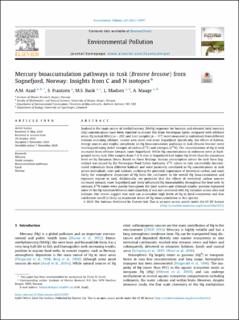| dc.description.abstract | Seafood is the main source of methylmercury (MeHg) exposure for humans and elevated total mercury (Hg) concentrations have been reported in marine fish from Norwegian fjords compared with offshore areas. Hg in tusk fillets (n = 201) and liver samples (n = 177) were measured in individuals from different habitats including offshore, coastal area, outer and inner Sognefjord. Specifically, the effects of habitat, energy sources and trophic complexity on Hg bioaccumulation pathways in tusk (Brosme brosme) were investigated using stable isotopes of carbon (δ13C) and nitrogen (δ15N). The concentrations of Hg in tusk increased from offshore towards inner Sognefjord. While Hg concentrations in sediment were at background levels, tusk fillet samples from 7 of 8 sites in Sognefjord had higher Hg levels than the maximum level set by European Union. Based on these findings, human consumption advice for tusk from Sognefjord was issued by the Norwegian Food Safety Authority. δ13C values in tusk successfully discriminated individuals from different habitats and were positively correlated to Hg concentrations in tusk across individuals, sites and habitats, outlining the potential importance of terrestrial carbon and most likely the atmospheric deposition of Hg from the catchment to the overall Hg bioaccumulation and exposure regime in tusk. Additionally, we postulate that the effects of terrestrial carbon sources increased towards inner Sognefjord and likely influenced Hg bioavailability throughout the food web. In contrast, δ15N values were patchy throughout the fjord system and although trophic position explained some of the Hg variation between individual fish, it was not correlated with Hg variation across sites and habitats. Our results suggest that tusk can accumulate high levels of Hg in fjord ecosystems and that catchment runoff is likely an important driver of Hg bioaccumulation in this species. | en_US |
